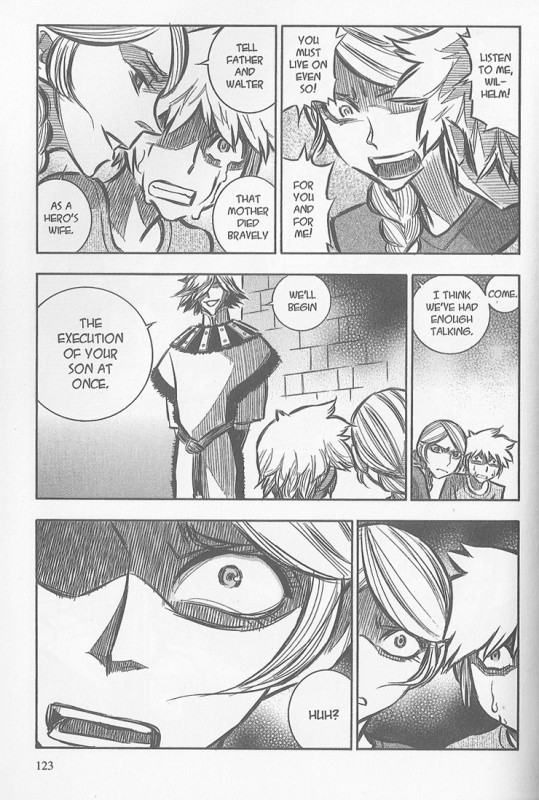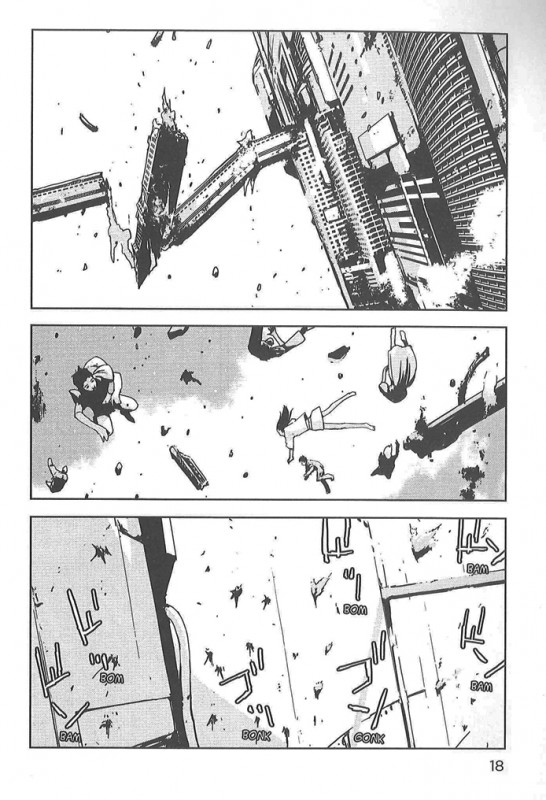
Q Hayashida’s Dorohedoro: violence comix
June 25th, 2014 Posted by david brothers
This chapter break from Q Hayashida’s Dorohedoro (print, digital, but buy it on iBooks or Android if you want it mobile) sums up a lot of what I like about her style. She works in this kinda gritty, grimy occult comics style, and while the surface-level stuff is great—the skulls, the snakes, the black smoke—what really makes it go is how grounded it is. It’s a comic about wizards and demons that wear street clothes, Nike Dunks, and custom masks.
Block out this guy’s arms and skulls; focus on his body and head. The stuff I’m noticing are the way the belt fits around his waist, the rumpled clothes, and his jacket flaring out. The hood over the eyes is a look I’ve chased several times over the course of my life. The HR Giger-esque rib-piece is pretty out there, but by and large, this guy is wearing clothes you’d see people rocking in the street. It’s a “cool” look. The snakes and skulls add to it, giving it that occult feeling.

Here’s a spread from Dorohedoro, volume 12. Hayashida’s great at making regular buildings look like they’re on the wrong side of the tracks in Hell. It’s very different from Mike Mignola’s more ornate and classic approach, where Hell is Movie Prague, full of long long hallways, classic buildings, and traditional environments. Hell-as-University. Hayashida’s Hell has food trucks and everything’s a slum covered in a thick coating of grime, like smog after it settles.
I like the implied menace in the bottom tier, too. The fisheye effect heightens the X vs Y aspect of things, but Hayashida’s style is great at maintaing a consistent level of background menace, too. It makes it look like the crew on the left got caught in the act by the crew on the right, which is literally true. But the hallway they’re in is great. There’s dust clouds, filthy walls, an alarm box or something on the far left, and you just know that if this were animated, the bare bulb on the right would flicker so that the hallway was more dim than lit. The smudges make me think of water damage, like the building is as run-down as it gets without being marked for destruction.
The fisheye effect makes me feel like this is a moment to breathe in just before the curtain comes down and the violence starts. Luckily, this comes a few pages later:

T-shirts, jeans, polos, and intense action. The violence is obvious and extreme, with the claw end of a hammer and pure brute force getting the job done. I like the storytelling when the swordsman gets grabbed a whole lot. It got me thinking about which panels we’re seeing are specific POV panels and which are meant to be our standard third-person view. The man with the sword gets grabbed, and the following panel is his view: we see a blurry, blacked-out vision of a face. Then, in the next panel, we’re tracking his reaction. His instinct is to draw his sword, but Noi, the masked arm-puller, is ahead of him. And the potential energy in that panel, when he realizes he’s stuck and you realize he’s stuck and what’s coming next is going to be bad—yes. This is Q Hayashida.
On the facing page, that laugh is everything. Dorohedoro is a great comic because Hayashida blends great jokes with explicit violence and grim mood-building. There are sentient gyoza creatures, rotted husks of men, and capricious demons in the same world. Some of the demons even like gyoza. Noi’s laugh manages to combine all of that. It’s dark humor, and the blood spray is extreme, but it’s also a perfect demonstration of how much and what kind of trouble these guys are in.
Covered in the blood of their friend, whose arm she just successfully yanked off, and taking time for a hearty, gleeful laugh: Noi gives pause.









